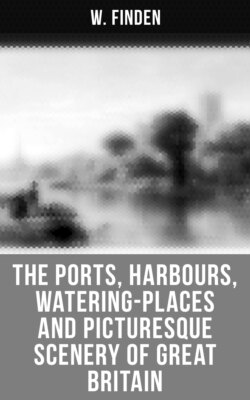Читать книгу The Ports, Harbours, Watering-places and Picturesque Scenery of Great Britain - W. Finden - Страница 10
На сайте Литреса книга снята с продажи.
YARMOUTH, WITH NELSON'S PILLAR,
(FROM THE LOWESTOFT ROAD).
ОглавлениеTable of Contents
"A fertile soil, a fruitful sea,
And wealth amassed by Industry;
And patriot virtues that sustain
Their 'Meteor-flag' on land and main;
A scene where Nelson's gallant name
Is 'watch-word' to immortal fame:
And here—with grateful triumph crown'd—
Imparts a charm to all around."
Yarmouth Pillar.
Yarmouth, as a market-town and sea-port, enjoys many natural advantages; and, aided by the public spirit of its inhabitants and a train of successful enterprise, has long enjoyed a well-merited distinction in the chart of the British Empire. It is a borough, both corporate and parliamentary, situated at the eastern extremity of the county, near the mouth of the river Yare, from which it derives its name, and which is navigable as far as Norwich. Joined by its tributaries, the Waveney and Bure, a short distance to the west of the town, in a fine sheet of water called the Breydon, it proceeds in a copious stream to the sea. The Waveney and the Bure are both navigable rivers—the former as far as Bungay, and the latter to Aylsham.
The town, extending upwards of a mile along the river, from north to south, occupies an area of at least a hundred and thirty acres. On the western side it is bounded by the river, over which there is a handsome drawbridge, communicating with South Town or Little Yarmouth, one of its populous suburbs, where extensive business is carried on. The principal streets, running north and south—Regent-street and South-street excepted—are all indicative of the stir and animation which pervade every place of trade, and evince in their construction both taste and comfort, with an occasional air of the picturesque. The market-place of Yarmouth is extensive, covering an area of nearly three acres, and inclosed on the west side with a range of handsome and well-furnished shops.
Among the public edifices of Yarmouth, which merit especial notice, is the Town Hall, which stands near the centre of the quay. It is an elegant modern structure, with a portico admirably proportioned, and supported by pillars of the Tuscan order. The interior consists of a noble room, finely designed and ornamented, with a richly embossed ceiling in stucco, from which are suspended three massive and superbly cut lustres, containing seventy-six lights, which are used on festive nights, when, with permission from the mayor, public assemblies are held within its walls. Over the chimney-piece is a full-length portrait of George III., in which is preserved a faithful resemblance of that sovereign. The theatre, erected about sixty years ago, and the bathing-establishment, with a spacious public room adjoining, where the company are supplied with refreshments, are among the other places of public resort. A jetty, twenty-four feet wide, secured by a strong railing, and extending four hundred and fifty-six feet into the sea, on piles of wood, forms a delightful promenade, where health of body and exhilaration of mind may be greatly promoted by the salubrious sea breezes by which it is constantly visited. Near this, and commanding a magnificent view over the German Ocean, the stranger is particularly struck with the appearance of a marine villa, which harmonises admirably with the scene.
At a short distance from the pier is a noble pile of buildings, belonging to the barrack department and erected on a portion of the South Denes. In the centre of the latter rises the triumphal Pillar, which forms so striking a feature in the landscape, and awakens so many proud and heroic associations in the heart of the spectator. This monument, raised to commemorate in his native county the services of the immortal Nelson, is worthy of the virtue and valour it was designed to celebrate. It was erected in 1817, by W. Wilkins, Esq. Both in the design and execution great solicitude was evinced by the public that a monument, bearing the name of the greatest of our Naval Heroes, should present everything that classical taste and national gratitude could suggest—and in this respect his countrymen have been fully gratified. It is of the Doric order, fluted and ornamented with appropriate decorations and title-inscriptions—illustrating the Hero's most celebrated battles—and surmounted with a ball and an exquisitely cast figure of Britannia, supporting her trident and laurel wreath. The ascent is by an easy flight of two hundred and seventeen steps, and the whole is built of white Scottish marble. Its height from the ground is one hundred and forty-four feet; the diameter of the column or shaft is twelve feet six inches; and the pedestal is twenty-three feet square by twenty-seven feet in height.
CROMER.
